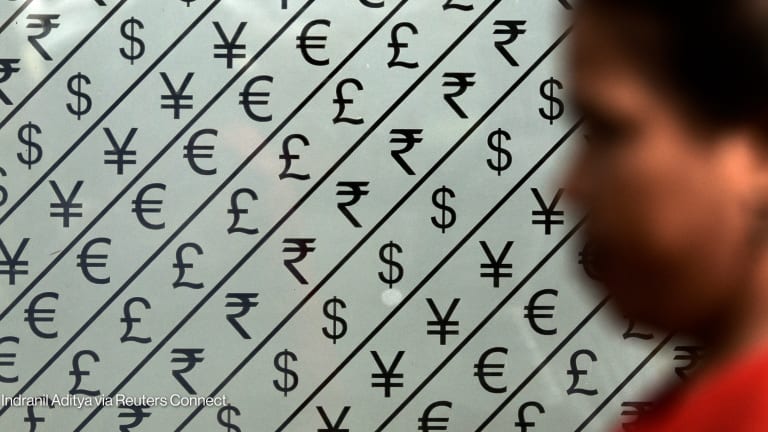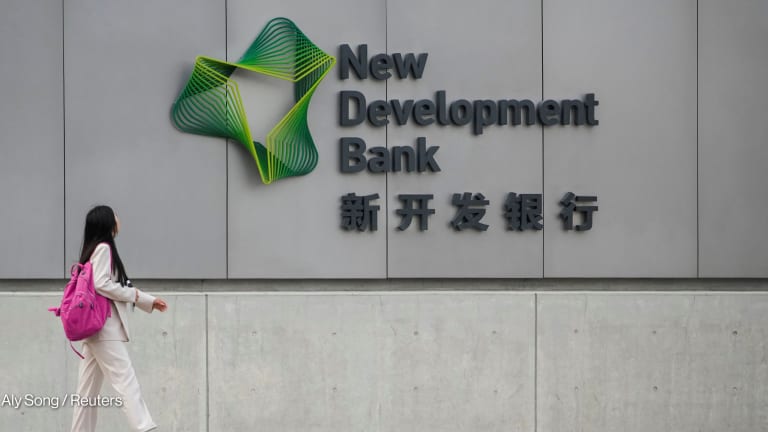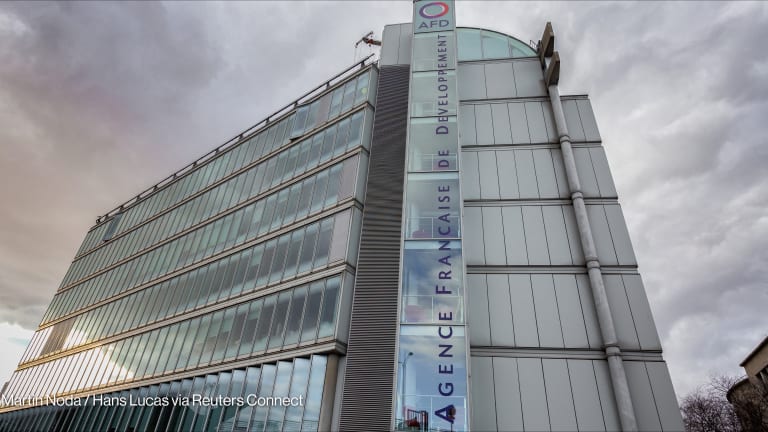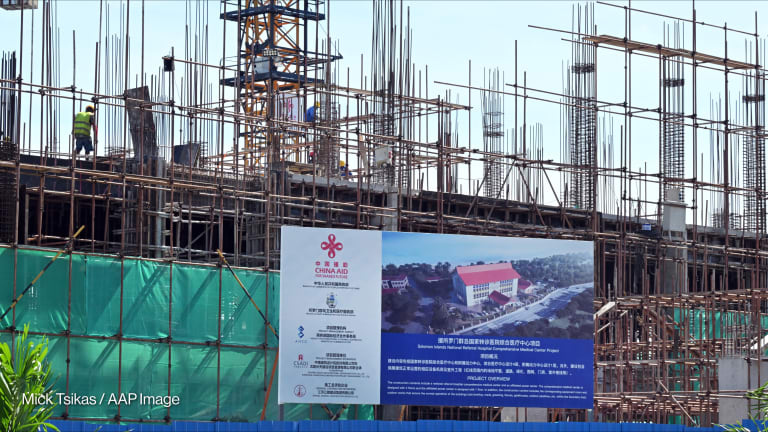EBRD had €14.8B in the pipeline for non-EU projects last year. Here's a breakdown.
Devex takes a look at EBRD's geographic and sectoral priorities beyond the EU's borders in 2020.
In the 30 years since its establishment, the European Bank for Reconstruction and Development has evolved from an institution focused on supporting the transition to open market economies in the Eastern bloc to one that aims to tackle sustainability challenges across the 38 countries and regions where it currently works. The bank committed a total of €11 billion in 2020, including €8.2 billion outside of EU countries, according to figures shared with Devex. But looking at EBRD’s broader project pipeline in 2020 — including projects that were under implementation, had been approved and signed by the board, or were in preparation stages — Devex identified 269 projects in non-EU countries published on its website, worth a total of €14.8 billion. In this article, we look at those projects to uncover the bank’s geographic and sectoral priorities outside the EU. Although most of these projects are co-financed by other institutions, this analysis focuses only on EBRD’s contributions, rather than the overall project cost. Read on to learn about the countries and regions where EBRD is investing outside the EU, or skip to the “sectoral priorities” section to learn about the thematic focus of its investments. Where does EBRD invest outside the EU? EBRD’s non-EU 2020 investments were focused on Eastern Europe, the Eastern and Southern Mediterranean, and Central Asia. Two projects worth €5.5 billion had a global scope across all EBRD regions. Eastern Europe was the top non-EU region, receiving €4.4 billion for 101 projects in nine countries. Of that, investments in Ukraine accounted for about a third, or €1.48 billion, with projects mostly in transportation (€688 million) and agribusiness (€368 million). The state road agency Ukravtodor got a three-tranche loan totaling €450 million for the Ukraine Road Corridors project that supports national road infrastructure and promotes transparency to fight corruption. As for agribusiness, one of the biggest agricultural companies in Ukraine, Astarta Group, got a total of €208 million for a financing project on farming, sugar, and soybean processing. Meanwhile, the Southern and Eastern Mediterranean was allocated €2 billion for 40 projects, of which more than 40%, or €853 million, went to Egypt for 14 projects. A total of €456 million in liquidity lines went to local banks for on-lending to businesses, especially to SMEs. Morocco followed with almost €593 million for nine projects; the bank guaranteed €40 million to Agence Nationale des Ports, on top of Global Environment Facility funding, for the rehabilitation and infrastructure resilience of Moroccan ports. There were also multicountry projects in the Mediterranean region worth a total of €78 million that focused on equity investments in SMEs, equity investments in technology, and the development of health care platforms in North Africa. In Central Asia, the bank invested a total of €1.7 billion across 63 projects. The largest projects were in Kazakhstan, including a €244 million energy project to aid subsidiaries of KazTransGas to optimize energy efficiency in the country and a €206 million loan to the state-owned national road operator KazAvtoZhol to improve interregional connectivity and increase road capacity. In Uzbekistan, the bank financed a 1500 megawatt power plant in the Syrdarya region with a secured term loan of €167 million. In south eastern Europe, an EBRD region that covers the Western Balkans, the bank financed 63 projects worth €1 billion. It supported SMEs and private sector actors by providing €600 million in loans to local banks. This includes a three-year tenor unfunded guarantee of €100 million to the Raiffeisen Bank Sh.a Albania for new lending opportunities for MSMEs. EBRD also supported regional connectivity and infrastructure in the region, with Kosovo receiving a sovereign loan of €30 million for infrastructure providers affected by the pandemic. Meanwhile, North Macedonia received a €70 million loan for the construction of a bus rapid transit in Skopje. EBRD’s sectoral priorities What differentiates EBRD from other regional multilateral banks is that most of the borrowers and clients of its services are private sector entities. According to its constitution, 60% of lending must go to the private sector, but its new strategic priorities approved in October raise that target to 75% for the 2021-2025 period. In 2020, about 75% of its non-EU investments were directed to the private sector, with 202 projects worth €9.2 billion, while 67 projects worth €5.5 billion went to public sector entities. Among the projects implemented by the private sector, more than half — 107 projects worth €6.6 billion — were related to financial institutions in non-EU countries. One of the examples is the establishment of a €50 million Western Balkans green economy financing facility for local financial institutions. According to its website, EBRD aims to support the financial sector to become the main driver of economies through funding resilient and efficient banks and improving financial sector integration and intermediation. Among the 1% of projects directed toward public entities in this sector, the biggest was the Deposit Protection Fund Montenegro, worth €50 million. The project aims to improve DPFM’s investment management capabilities and its emergency funding arrangement, which serves as a financial safety net to depositors. It is worth noting that about 60%, or €4 billion, of the total allocation to financial institutions outside the EU went through the Resilience Framework, EBRD’s flagship COVID-19 initiative. It aims to help EBRD’s members address the economic effects of COVID-19, and while some of its activities are directed to public entities, the overall project is identified as financial support for the private sector. One example of a project under the Resilience Framework is an €83 million allocation to Commercial International Bank, the largest private bank in Egypt, to be loaned to SMEs and corporates. After financial institutions, the second-biggest sector for EBRD’s non-EU investments in 2020 was municipal and environmental infrastructure, with €2.9 billion for 41 projects, ranging from transport to energy infrastructure. In contrast with the financial sector, more than 95% of these investments, or €2.8 billion, were directed to public entities or governments. A stabilization facility in Morocco worth €150 million was one of the biggest projects for a single country. The loan will help Office National des Aeroports continue providing essential operations and services despite the financial effects of the pandemic. From a regional standpoint, Green Cities 2 — a multicountry project that addresses environmental challenges at the city level — got a total of €1.5 billion. Energy projects, such as renewable energy and power supply projects, worth €2 billion for 26 projects, were also among the bank’s top priorities. The STEG Liquidity and Restructuring Facility — which will allow Societe Tunisienne de l'Electricite et du Gaz to reform and develop Tunisia's electricity sector — was the biggest signed project in this sector, worth €300 million. Raquel Alcega contributed to this piece. Update, March 9, 2021: The headline and text of this article were amended to clarify the parameters of the analysis. Track EBRD investments and opportunities in the Devex funding database with a Devex Pro Funding membership — and access in-depth analysis, insights, and funding opportunities from over 850+ sources, combined with Devex Pro news content.
In the 30 years since its establishment, the European Bank for Reconstruction and Development has evolved from an institution focused on supporting the transition to open market economies in the Eastern bloc to one that aims to tackle sustainability challenges across the 38 countries and regions where it currently works.
The bank committed a total of €11 billion in 2020, including €8.2 billion outside of EU countries, according to figures shared with Devex. But looking at EBRD’s broader project pipeline in 2020 — including projects that were under implementation, had been approved and signed by the board, or were in preparation stages — Devex identified 269 projects in non-EU countries published on its website, worth a total of €14.8 billion.
In this article, we look at those projects to uncover the bank’s geographic and sectoral priorities outside the EU. Although most of these projects are co-financed by other institutions, this analysis focuses only on EBRD’s contributions, rather than the overall project cost.
This story is forDevex Promembers
Unlock this story now with a 15-day free trial of Devex Pro.
With a Devex Pro subscription you'll get access to deeper analysis and exclusive insights from our reporters and analysts.
Start my free trialRequest a group subscription Printing articles to share with others is a breach of our terms and conditions and copyright policy. Please use the sharing options on the left side of the article. Devex Pro members may share up to 10 articles per month using the Pro share tool ( ).
Janadale Leene Coralde works as a contributing analyst for Devex. Based in Manila she reports on development donors activities and designs funding data visualisations. She has a degree in political economy, specializing in international relations and development, and has previously worked as a researcher for Chemonics, the REID foundation, and the Philippines House of Representatives.
Miguel Tamonan is a Senior Development Analyst at Devex, where he analyzes data from public and private donors to produce content and special reports for Pro and Pro Funding readers. He has a bachelor’s degree in Political Science with a Major in International Relations from the Polytechnic University of the Philippines.









